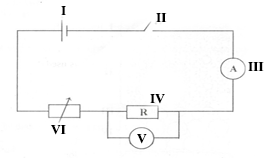ESSAY
This paper is in two parts: I and II. Answer Question 1 in part I and any other four question in part II
PART I
[40 marks]
Answer all of Question 1
-
The diagram below is an illustration of a fish.
Study the diagram carefully and answer the questions that follow.
-
Identify the fish.
-
Name each of the parts labeled I, II, III, V.
-
Name that habitat of the fish.
-
Explain how each of the parts labelled III and VI enables the fish adapt to its habitat.
-
-
The diagram below is an illustration of a section through the soil.
Study the diagram carefully and answer the questions that follow.
-
What does the diagram represent?
-
Name each of the parts labelled I, II, III, IV.
-
Which part of the diagram:
α) is the richest in humus?
β) is the habitat for soil organisms?
γ) undergoes weathering?
-
What is the effect of heavy rainfall on the part labelled I?
-
-
The diagram below is an illustration of an electrical circuit.
Study the diagram carefully and answer the questions that follow.

-
Name each of the parts labelled I, II, IV, VI.
-
State the energy transformation that takes place in:
α) I
β) IV
-
State the S.I units of the quantity measured by each of the parts labelled:
α) III
β) V
-
State the function of the part labelled VI.
-
-
In an experiment, equal volumes and equal concentrations of dilute hydrochloric acid and dilute sodium hydroxide solutions were each placed in different test tubes.
Read the following statements carefully.
-
Both red and blue litmus papers were dipped into each of the solutions in turns.
-
Equal volumes of the solutions were mixed to obtain a third solution.
-
Both red and blue litmus papers were dipped into the third solution.
Use the information provided to answer the following questions.
-
Explain briefly how you can identify each of the solutions:
α) Hydrochloric acid
β) Sodium hydroxide
-
State the types of reaction that occurred when the two solutions were mixed.
-
What type of solution was formed when the reaction stated in (ii) occurred?
-
State what would be observed when both red and blue litmus papers were dipped into the third solution.
-
Explain how the solid portion of the solution named in (iii) could be obtained.
-